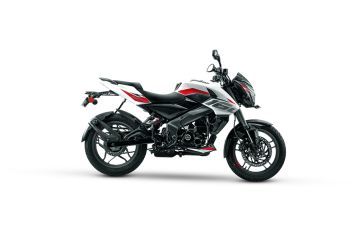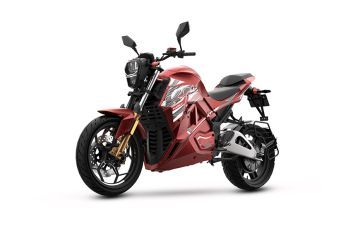Explore all New Cars of 2025
Bajaj Pulsar NS160 vs Kabira Mobility KM4000
Kabira Mobility KM4000 Price starts at Rs. 1.65 Lakh which is Rs. 18,694 costlier than base model of Bajaj Pulsar NS160 priced at Rs. 1.47 Lakh. The claimed mileage of Bajaj Pulsar NS160 is 40.36 kmpl. In technical specifications, Bajaj Pulsar NS160 is powered by 160.3 cc engine. Bajaj Pulsar NS160 is available in 4 different colours while Kabira Mobility KM4000 comes with 1 colours. The Comparison Bajaj Pulsar NS160 vs Kabira Mobility KM4000 can be described on the basis of price and specifications.
Pulsar NS160 vs KM4000
| Key Highlights | Pulsar NS160 STD | KM4000 STD |
|---|---|---|
| Engine Type | Oil Cooled, Twin Spark, 4-Valve FI DTS-i | ... |
| Max Power | 17.2 PS @ 9000 rpm | 12 kW |
| Top Speed | 120 kmph | 120 km/Hr |
| Range | ... | 178 km/charge |
| Charging Time | ... | 3 Hr |
-
Bajaj Pulsar NS160
 Rs. 1.47 Lakh EMI - Rs. 4,400 View February OffersKabira Mobility KM4000
Rs. 1.47 Lakh EMI - Rs. 4,400 View February OffersKabira Mobility KM4000 Rs. 1.65 Lakh View February Offers
Rs. 1.65 Lakh View February Offers
Pulsar NS160 vs KM4000 Key Highlights
| Basic Info | Bajaj Pulsar NS160 STD | Kabira Mobility KM4000 STD |
|---|---|---|
| Rating |
330 reviews
|
24 reviews
|
| Brand Name | Bajaj | Kabira Mobility |
| Ex-Showroom Price | Rs. 1.47 Lakh Check On Road Price | Rs. 1.65 Lakh Check On Road Price |
| Engine Type | Oil Cooled, Twin Spark, 4-Valve FI DTS-i | ... |
| Max Power | 17.2 PS @ 9000 rpm | 12 kW |
| Fuel Type | Petrol | Electric |
| Colors | ||
| Brakes Front | Disc | Disc |
| Brakes Rear | Disc | Disc |
| Braking Type | ... | Combi Brake System |
| Wheel Size | Front :-431.8 mm,Rear :-431.8 mm | Front :-431.8 mm,Rear :-431.8 mm |
| Wheels Type (Pressed Steel/ Alloy) | Alloy | Alloy |
| Range | ... | 178 km/charge |
| Charging Time | ... | 3 Hr |
| ABS | Dual Channel | ... |
| Starting | Self Start Only | Push Button Start |
| Speedometer | Digital | Digital |
| Running Cost | Rs. 2.48/km | Rs. 0.15/km |
| EMI |
Rs. 4,400
@
11.99% (36 months)
|
... |
| Insurance | Rs. 11,165 Pulsar NS160 Insurance | Rs. 6,234 KM4000 Insurance |
| Brochure |
Download
Brochure
|
Download
Brochure
|
Engine/Motor |
|
|||||||||||||||||||||||||||||||||||||||||||||||||||||||||||||||||||||||||||||||||||||||
|---|---|---|---|---|---|---|---|---|---|---|---|---|---|---|---|---|---|---|---|---|---|---|---|---|---|---|---|---|---|---|---|---|---|---|---|---|---|---|---|---|---|---|---|---|---|---|---|---|---|---|---|---|---|---|---|---|---|---|---|---|---|---|---|---|---|---|---|---|---|---|---|---|---|---|---|---|---|---|---|---|---|---|---|---|---|---|---|---|
Brakes |
|
|||||||||||||||||||||||||||||||||||||||||||||||||||||||||||||||||||||||||||||||||||||||
Performance |
|
|||||||||||||||||||||||||||||||||||||||||||||||||||||||||||||||||||||||||||||||||||||||
Tyres |
|
|||||||||||||||||||||||||||||||||||||||||||||||||||||||||||||||||||||||||||||||||||||||
Dimensions |
|
|||||||||||||||||||||||||||||||||||||||||||||||||||||||||||||||||||||||||||||||||||||||
Electricals |
|
|||||||||||||||||||||||||||||||||||||||||||||||||||||||||||||||||||||||||||||||||||||||
Features |
|
|||||||||||||||||||||||||||||||||||||||||||||||||||||||||||||||||||||||||||||||||||||||
Warranty |
|
Pros and Cons
- Positives
- Negatives
Bajaj Pulsar NS160
- It packs a pretty powerful engine
- Shares the capable perimeter frame with larger Pulsars
- Stopping power is pretty good.
Bajaj Pulsar NS160
- Engine refinement could have been better
- It isn’t feature-rich like its segment rivals
- It is the heaviest 160cc motorcycle.
Is Kabira Mobility KM4000 Better Than Bajaj Pulsar NS160?
100% users have chosen Kabira Mobility KM4000 over Bajaj Pulsar NS160 in a survey being conducted on zigwheels.com.
Apart from this survey a total of 1434 users have also rated Kabira Mobility KM4000 and Bajaj Pulsar NS160 on some really important factors like Mileage , performance, comfort, safety etc. and have given their personal opinions about these bikes.
Kabira Mobility KM4000 has out rated Bajaj Pulsar NS160 on all the rating factors.
Before making your decision you should also consider the unbiased and thorough analysis of these bikes on every aspect by our auto experts who have summarised the analysis in pros, cons and final conclusion..
| Ratings Factor | KM4000 | Pulsar NS160 |
|---|---|---|
| Mileage | 4.4 | 3.8 |
| Performance | 4.5 | 4.4 |
| Comfort | 4.3 | 4.2 |
| Maintenance | 4.3 | 3.8 |
| Features | 4.5 | 4.4 |
Videos of Bajaj Pulsar NS160 and Kabira Mobility KM4000
-
2023 Bajaj Pulsar NS200 And Pulsar NS160 First Ride Review - Road + Track | USD Fork Added 25 Mar, 2023 18644 views
-
160cc Sporty Commuters Compared On Acceleration, Fuel Efficiency, Price And Features | ZigWheels 30 May, 2023 5493 views
-
2023 Bajaj Pulsar NS160 & Pulsar NS200 Walkaround | Revised hardware, new features and…? | Zigwheels 14 Mar, 2023 7138 views
-
Bajaj Pulsar NS 160 (2017) : The Good And The Bad : PowerDrift 15 Aug, 2017 465742 views
-
Bajaj Pulsar NS160 (2017) : First Look : PowerDrift 16 Jul, 2017 283137 views
-
DIY: How to Lube your chain: PowerDrift 7 May, 2014 74827 views
Bajaj Pulsar NS160 Comparison with Similar Bikes
-
 BajajPulsar NS160Rs. 1.47 LakhvsPulsar NS160 vs Apache RTR 160 4V
BajajPulsar NS160Rs. 1.47 LakhvsPulsar NS160 vs Apache RTR 160 4V TVSApache RTR 160 4VRs. 1.24 Lakh
TVSApache RTR 160 4VRs. 1.24 Lakh
Latest News on Bajaj Pulsar NS160 and Kabira Mobility KM4000
-
 Bajaj Pulsar NS160 Flex Fuel Showcased At IBET (India Bio-Energy And Tech) Expo 20244 Sep, 2024 | By Team ZigWheels
Bajaj Pulsar NS160 Flex Fuel Showcased At IBET (India Bio-Energy And Tech) Expo 20244 Sep, 2024 | By Team ZigWheels -
 Kabira Mobility Launches Second-Gen Models Of The KM3000 and KM400014 Feb, 2024 | By Team ZigWheels
Kabira Mobility Launches Second-Gen Models Of The KM3000 and KM400014 Feb, 2024 | By Team ZigWheels -

-
 Kabira Mobility Amasses 6000 Bookings In Just 4 Days9 Mar, 2021 | By Team ZigWheels
Kabira Mobility Amasses 6000 Bookings In Just 4 Days9 Mar, 2021 | By Team ZigWheels -
 2024 Bajaj Pulsar NS160 And Pulsar NS200 Launched27 Feb, 2024 | By Team ZigWheels
2024 Bajaj Pulsar NS160 And Pulsar NS200 Launched27 Feb, 2024 | By Team ZigWheels -
 “Kabira Speaking! Our Bikes Have Been Launched”15 Feb, 2021 | By Team ZigWheels
“Kabira Speaking! Our Bikes Have Been Launched”15 Feb, 2021 | By Team ZigWheels -
 2024 Bajaj Pulsar NS200 And Bajaj Pulsar NS160 Unveiled Ahead Of Launch: Now More Feature-packed19 Feb, 2024 | By Team ZigWheels
2024 Bajaj Pulsar NS200 And Bajaj Pulsar NS160 Unveiled Ahead Of Launch: Now More Feature-packed19 Feb, 2024 | By Team ZigWheels -
 Kabira KM 4000 Electric Bike Spotted Testing2 Feb, 2021 | By Team ZigWheels
Kabira KM 4000 Electric Bike Spotted Testing2 Feb, 2021 | By Team ZigWheels -
 Updated Bajaj Pulsar NS160 Spotted Testing19 Jan, 2024 | By Team ZigWheels
Updated Bajaj Pulsar NS160 Spotted Testing19 Jan, 2024 | By Team ZigWheels
Recently Asked User Questions
Q. Which is better bike between Kabira Mobility KM 4000 and Kabira Mobility KM 3000?
- The KM 4000 and the KM 3000 share the same motor and lithium-ion battery pack, however, the usable capacity is different. While the naked uses a 4.4kWh pack, it goes down to 4kWh on its faired sibling. Even the power outputs are different. The 8kW motor on the naked churns 5kW of continuous power while the faired bike’s 6kW motor manages to produce 3.5kW of continuous power. With faired motorcycles generally associated with more performance, this comes as a bit of a surprise. In terms of hardware too, the KM 4000 gets better equipment in form of USD forks and dual discs at the front. The KM 3000 does with conventional telescopic forks and a single disc at the front. Both the bikes get the same disc at the rear and are aided by a combined braking system. Kabira says that their customer surveys revealed that customers were expecting more performance from the naked, while they wanted the faired bike to be more of a commuter. Moreover, we would suggest you to take a test ride before making the final decision. Follow the link and select your desired city for dealership details.
Q. Which bike is best Bajaj Pulsar NS 160 or Bajaj Pulsar NS 125?
- Bajaj Pulsar NS125 packs a peppy engine, is fun to ride, and could be the perfect beginner bike. The entry-level NS125 could be the perfect platform for those graduating from a scooter, and yearning to learn the ropes. The money you save could be a deposit for your next bike. On the other hand, Bajaj has done well to endow the NS160 with high-spec cycle parts and features while keeping the price in check. the Pulsar NS160 ticks all the right boxes when it comes to style, performance, ride and handling. Given Bajaj's extensive service network and low service costs, peace of mind is ensured. The new NS160 is a worthy contender and makes a strong case for itself in this highly competitive 160cc segment. Moreover, we would suggest you take a test ride before making the final decision. Follow the link and select your desired city for dealership details.
Q. Which is better between Yamaha FZ S version 3 (bs6) and Pulsar NS 160 (bs6). Kindly help me I considered many
in this 150/160 cc segment came to an conclusion between these two.
- Selecting the right bike would depend on several factors such as your budget preference on the segment, features required, engine options, brand preference, etc. Yamaha FZS-FI V3 offers a Big bike styling, with good features and a smooth engine. Yamaha FZS-FI V3 is powered by a 149 cc engine. This FZS-FI V3 engine generates a power of 12.4 PS @ 7250 rpm and a torque of 13.3 Nm @ 5500 rpm. On the other hand, the Bajaj Pulsar NS160 BS6 might not have many tangible features to justify the price hike due to BS6 norms, it more than makes up for it with raw performance. In fact, it is the most powerful motorcycle in its segment, making it ideal for enthusiasts who prioritize performance over anything else. Bajaj Pulsar NS160 is powered by 160.3 cc engine.This Pulsar NS160 engine generates a power of 17.2 PS @ 9000 rpm and a torque of 14.6 Nm @ 7250 rpm. Moreover, we would suggest you to take a test ride before making the final decision. Follow the link and select your desired city for dealership.
Bajaj Pulsar NS160 Vs Kabira Mobility KM4000 FAQs
Which bike is best between Bajaj Pulsar NS160 vs Kabira Mobility KM4000?
Kabira Mobility KM4000 has out rated Bajaj Pulsar NS160 on all the rating factors.
Which bike is cheaper Bajaj Pulsar NS160 vs Kabira Mobility KM4000?
The Bajaj Pulsar NS160 is cheaper than Kabira Mobility KM4000 by Rs. 18,694.
Which bike offers better performance Bajaj Pulsar NS160 vs Kabira Mobility KM4000?
As per the users experiences the Bajaj Pulsar NS160 has better performance.
Images of Bajaj Pulsar NS160 and Kabira Mobility KM4000
Which one do you like more?
×











